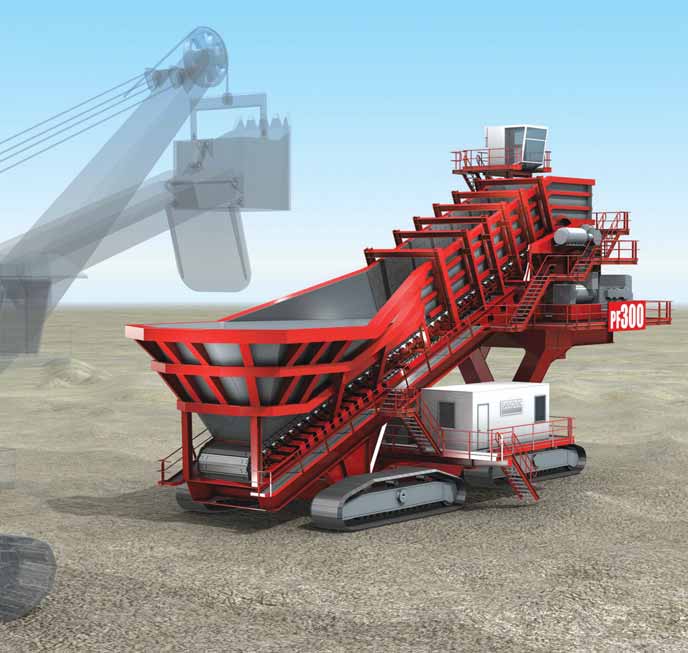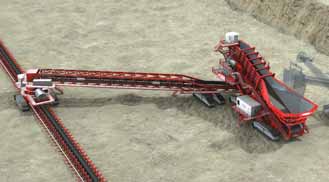
Sandvik’s new PF300 mobile crushing plant employs a highly compact design that offers superior stability.
Sandvik Sharpens In-Pit Crushing Focus
Major mining equipment supplier Sandvik Mining and Construction has announced
a full-fledged Fully Mobile Crushing Plant, the PF300
By Kyran Casteel, European Editor

Introduced in 1993–94 by the then Nordberg for quarrying, the in-pit crushing and conveying (IPCC) concept with a mobile crusher following an excavator along the face and discharging to a linked conveyor system has been scaled up for mining applications since 2000. As discussed in E&MJ, June 2008 (pp 46-52), U.K.-based MMD engineered a mobile sizer and conveyor system in 2002 to work with electric mining shovels pre-stripping overburden at BMA’s Goonyella Riverside coal mine in Queensland, Australia, and subsequently supplied Suncor’s first fully mobile unit for oil sands in Canada. In 2005, ThyssenKrupp Fördertechnik (TKF) sold a fully mobile double roll crusher plant and supporting belt wagons and conveyors for use at the YiMinHe coal mine in China and later Krupp Canada began work on a plant/bridge conveyor setup for Suncor Energy. In 2007, Tenova TAKRAF commenced work on a fully mobile crushing plant and related equipment for Rio Tinto Coal Australia’s Clermont project in Queensland. The Suncor machine is scheduled to be commissioned this Spring and has a nominal capacity of 7,000 mt/h, matched to the mine’s electric shovel loading capacity. Meanwhile TKF has received an order for four fully mobile crushing systems from another Chinese coal mine. Three of the 6,000 mt/h systems will strip overburden, TKF reports.
Joy Global, intent upon gaining from synergies achieved by focusing its P&H Mining Equipment, Stamler and Continental Conveyor divisions on an IPCC solution, has indicated it expects to complete engineering design of a 10,000- to 12,000-st/h-capacity integrated system matched to its P&H 4100 shovel class sometime in 2009 and is tentatively targeting an unspecified date in 2011 for first in-pit installation.
Sandvik’s PF300, where P signifies Project, F is Fully mobile crushing plant, and 300 indicates the unit is a special category without a boom, has not been designed to meet a specific order. Thomas Jabs, Sandvik Mining and Construction’s vice president of TechCenters Materials Handling, said: “We see strong signs of interest in fully mobile crushing concepts in all the big mining markets. Engineering houses and operating houses worldwide are seeking alternatives to truck intensive mining to reduce maintenance costs, operational costs and to reduce the CO2 footprint. This is where the fully mobile crushing concept perfectly fits and what the PF300 is developed for.”
The PF300 concept itself, Jabs explained, is the result of a broad-based Sandvik analysis of the current IPCC situation in general. This approach combined in detail and in depth market research by Sandvik’s Mining Technical Services team with the extensive pool of mobile machine expertise within the company and with the experience gained through Sandvik’s presence in supplying IPCC solutions—more than 120 delivered mobile machines for surface mining and materials handling applications worldwide over the past five years. The design process started in early 2008 after conceptual studies and various technical analyses had been carried out.
Jabs considers the PF300 a completely new, totally integrated IPCC system for on-face mining applications. And it is delivered by one supplier, he emphasizes—it’s totally Sandvik. “Certainly a specific tailoring of the machine to the client’s application will always be necessary, driven by factors like ground pressure, product size, material properties and environmental conditions. The PF300 has specifically been designed to accommodate the required adaptation,” said Jabs. Sandvik expects the PF300 to achieve a big breakthrough as an essential tool in the area of in-pit crushing and conveying, offering significant benefits for customers’ mining applications.

Sandvik sees the low weight of the PF300 as one big advantage over previous designs. Another key differentiating feature, Jabs pointed out, is that the machine can be equipped with a sizer, or a double-roll crusher or a hybrid, for any client’s multiple applications: Sandvik does not rely on only one crushing principle but can select and offer the most effective crusher to the client. The hybrid is a roll crusher that combines the advantages of a sizer and a double roll crusher, thereby closing the gap between these two by introducing high inertia crushing and very good intake behavior. It was designed especially for excellent and higher performance than the common sizer and double roll crushers and also for more critical applications such as abrasive and clogging materials. It is fully automatically controlled and adjustable from the operator’s control room.
Sandvik has used new and patent-pending technology to achieve a unique and recently developed stability concept for the PF300. This unique idea allows hydraulic excavators or rope shovels to load the crusher without any temporary support. The stability concept of the PF300 is based on having two sets of crawlers, Jabs explained. One set is located at the hopper area where impacts are inevitable from shovel bucket dumping, and the second set is located under the crusher. This second set is the steering crawler pair and works according to proven design concepts already used in Sandvik mining equipment such as bucketwheel excavators and spreaders. This design minimizes movement of the upper structure from load impacts in the hopper and makes the machine much more stable compared with most of the known design concepts. This not only keeps availability at a high level, but also improves the positioning of the machine.
By shifting the discharge device to a separate system, boom oscillation is completely uncoupled from the hopper loading by the shovel. The PF300 can work in combination with fully mobile belt wagons, transfer conveyors, or load bridges as the connecting downstream link to the face conveyor. The loading bridges are derived from the Sandvik design concept proven on spreaders or bucketwheel excavators and enable the system to work in double or triple block operations, hence reducing shifting sequences of the face conveyors as the mine advances.
Wider Range
As the PF300 is able to be operated with sizers, roll crushers
or hybrids and has excellent technical properties, the system
will be primarily marketed for use in coal, overburden
and oil sands but may also be able to process harder materials,
depending on the compressive strength of the material,
product size and suitability for crushing by roll crushers. The
current design aims at a capacity of approximately 10,000
mt/h as Sandvik sees the highest potential in this class, but
higher and lower capacities will be available. The anticipated
range will be between 2,000 mt/h and 14,000 mt/h,
depending on material density.
Although Sandvik Mining and Construction already offers a highly diverse range of mining and materials handling equipment, Jabs said the new fully mobile crushing station is strategically very important for the company since it demonstrates Sandvik’s innovative capability and determination to extend the range of solutions provided for customers as their needs change.